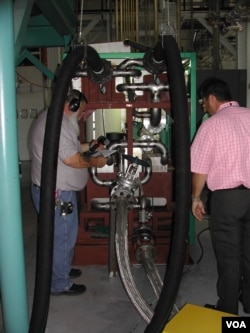DALLAS, Texas — Sixty percent of all energy generated in the world today is lost as wasted heat, according to Loy Sneary. The CEO of Gulf Coast Green Energy wants to capture some of that heat from the thousands of oil and gas wells in Texas – as well as other places – and turn it into electricity.
“We’ve got more electricity than could be generated by all the coal-fired power plants, natural gas-fired power plants and nuclear power plants in the world," he says. "That’s what the potential is.”
Deep underground, Sneary explains, the earth is already hot. Drive a diamond drill down into hard rock or shale, and the bit gets even hotter. Liquid cools it. That’s where Sneary’s Green Machine comes in.
Housed in a square box smaller than a compact car, the device channels the abundant hot well water through a pipe which runs next to another filled with refrigerant. The refrigerant boils and vaporizes at low temperatures and the resulting steam is used to generate electricity.
“So we can take these lower temperatures, hot water sources, and transfer the heat," Sneary says, "and then once that refrigerant is expanded and pressurized, from there on it’s just like a steam turbine.”
It’s not just oil and gas wells that provide waste heat for the Green Energy Machines to convert into electricity, the heat recycling technology can also work with solar energy arrays, coal-fired power plants, internal combustion engines and virtually any other industrial process that produces waste heat.
Last year, Sneary connected his device to the boilers at Southern Methodist University in Dallas and converted that system’s waste heat into electricity, helping to cut the university’s utility bills.
Sneary says the Green Energy machine can generate enough electricity to power up to 70 homes at a fraction of the cost of power generated by a coal-fired plant.
SMU’s Geothermal Lab Coordinator, Maria Richards, says her lab’s custom temperature maps help Sneary find hot spots associated with petroleum drilling operations where he can deploy his machines. The school and Gulf Coast Green Energy have partnered for several years.
"There was really so much heat in the Gulf Coast," Richards says. "That made us realize that, by working with the oil and gas wells, it was an ability to tap into those resources.”
Sneary is negotiating with drillers in Texas, has a project in West Virginia, and is looking at other states too. He says his company’s heat-capture technology is efficient and green because it’s emission-free. And given the growing number of oil-and-gas-well hot spots pinpointed on SMU’s geothermal map, Sneary expects his Gulf-Coast Green Energy machines will be in great demand for years to come.
“We’ve got more electricity than could be generated by all the coal-fired power plants, natural gas-fired power plants and nuclear power plants in the world," he says. "That’s what the potential is.”
Deep underground, Sneary explains, the earth is already hot. Drive a diamond drill down into hard rock or shale, and the bit gets even hotter. Liquid cools it. That’s where Sneary’s Green Machine comes in.
Housed in a square box smaller than a compact car, the device channels the abundant hot well water through a pipe which runs next to another filled with refrigerant. The refrigerant boils and vaporizes at low temperatures and the resulting steam is used to generate electricity.
“So we can take these lower temperatures, hot water sources, and transfer the heat," Sneary says, "and then once that refrigerant is expanded and pressurized, from there on it’s just like a steam turbine.”
It’s not just oil and gas wells that provide waste heat for the Green Energy Machines to convert into electricity, the heat recycling technology can also work with solar energy arrays, coal-fired power plants, internal combustion engines and virtually any other industrial process that produces waste heat.
Last year, Sneary connected his device to the boilers at Southern Methodist University in Dallas and converted that system’s waste heat into electricity, helping to cut the university’s utility bills.
Sneary says the Green Energy machine can generate enough electricity to power up to 70 homes at a fraction of the cost of power generated by a coal-fired plant.
SMU’s Geothermal Lab Coordinator, Maria Richards, says her lab’s custom temperature maps help Sneary find hot spots associated with petroleum drilling operations where he can deploy his machines. The school and Gulf Coast Green Energy have partnered for several years.
"There was really so much heat in the Gulf Coast," Richards says. "That made us realize that, by working with the oil and gas wells, it was an ability to tap into those resources.”
Sneary is negotiating with drillers in Texas, has a project in West Virginia, and is looking at other states too. He says his company’s heat-capture technology is efficient and green because it’s emission-free. And given the growing number of oil-and-gas-well hot spots pinpointed on SMU’s geothermal map, Sneary expects his Gulf-Coast Green Energy machines will be in great demand for years to come.








